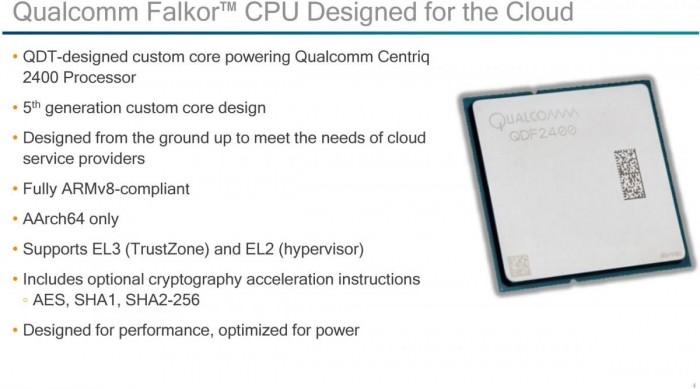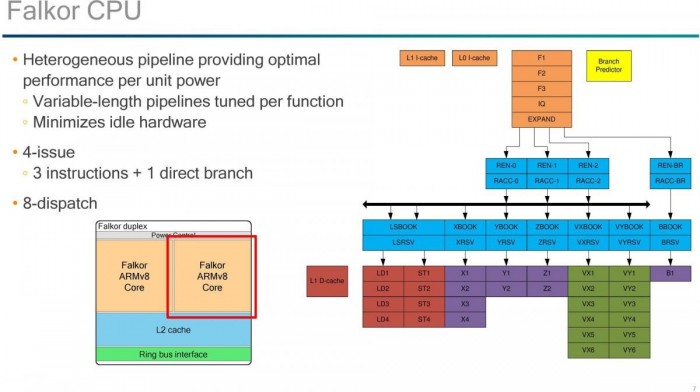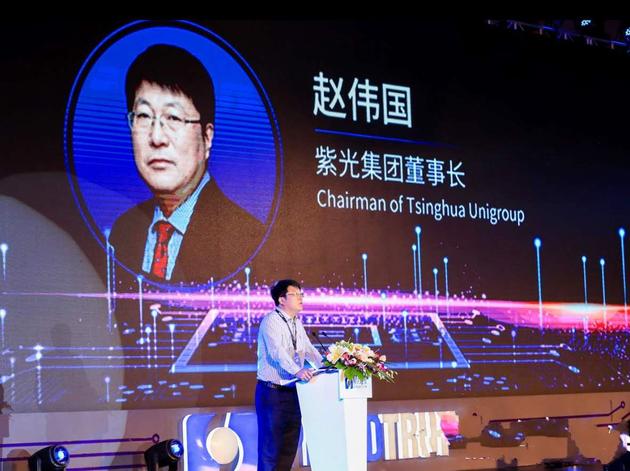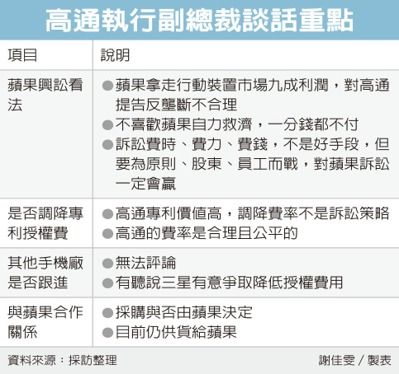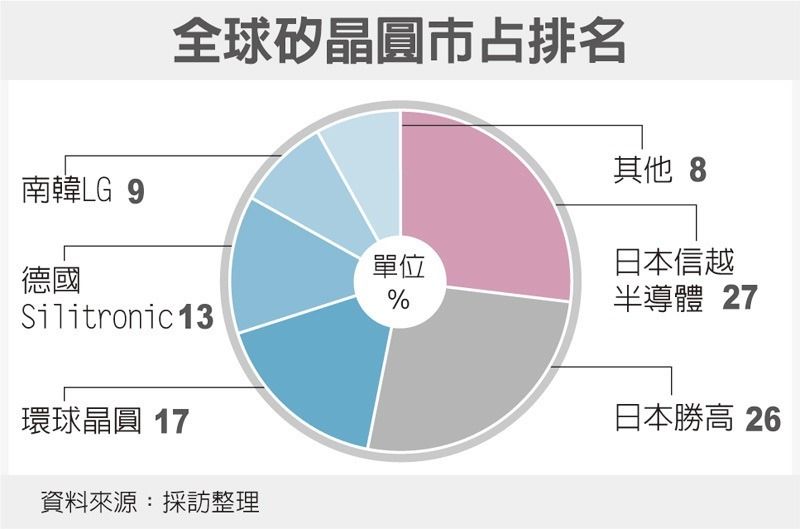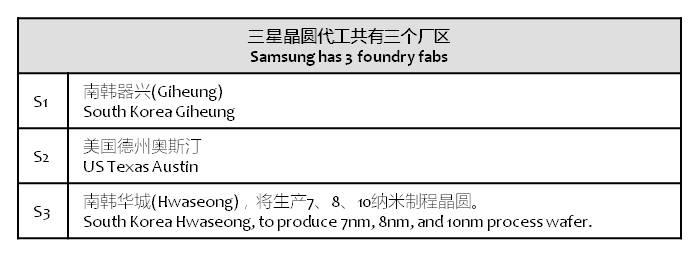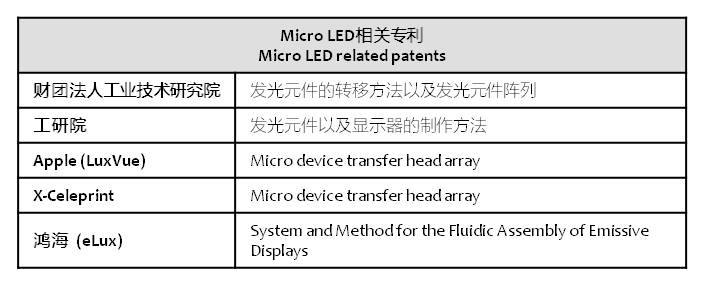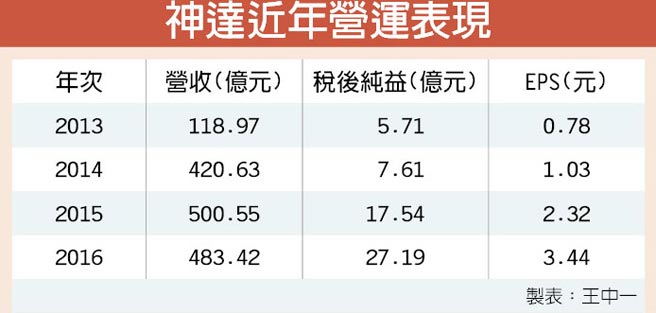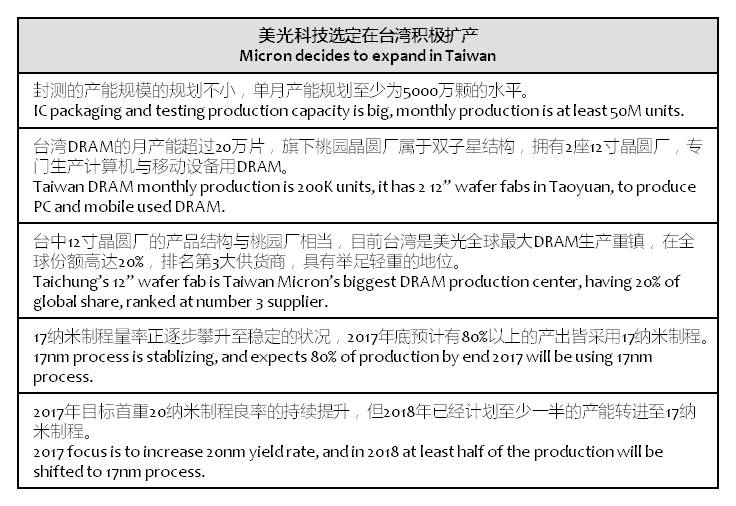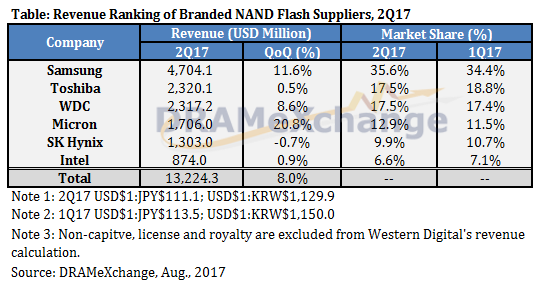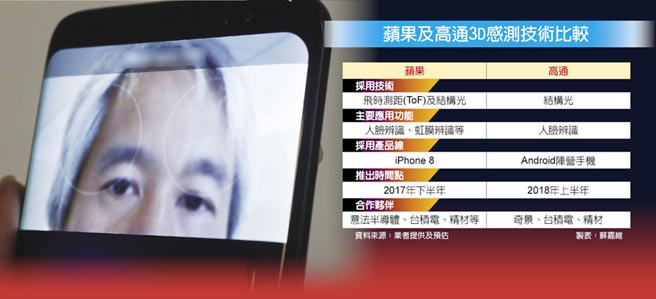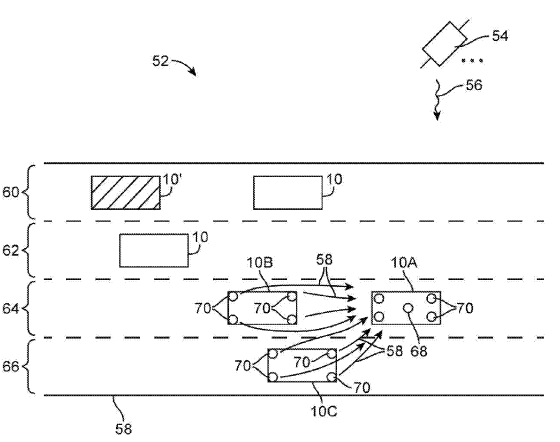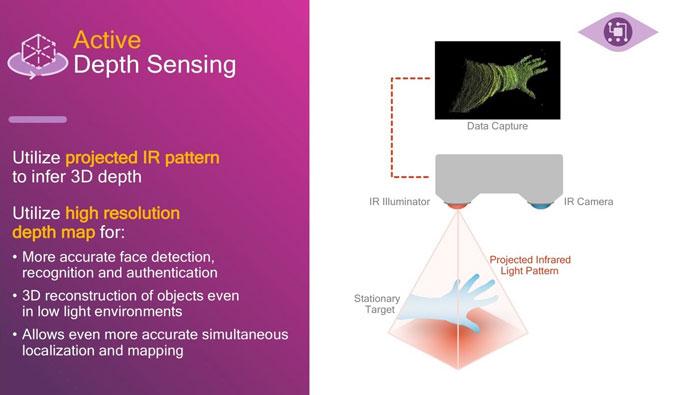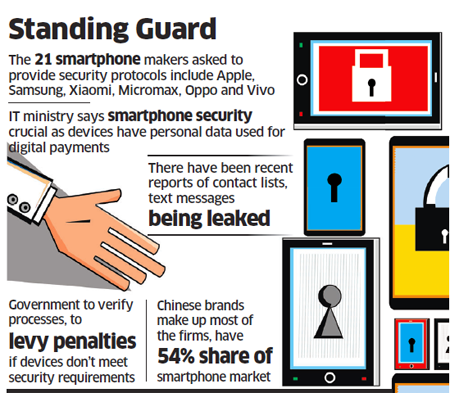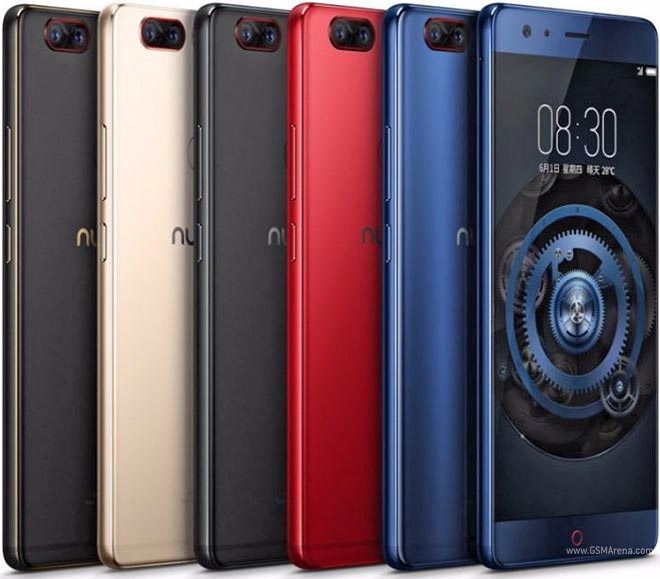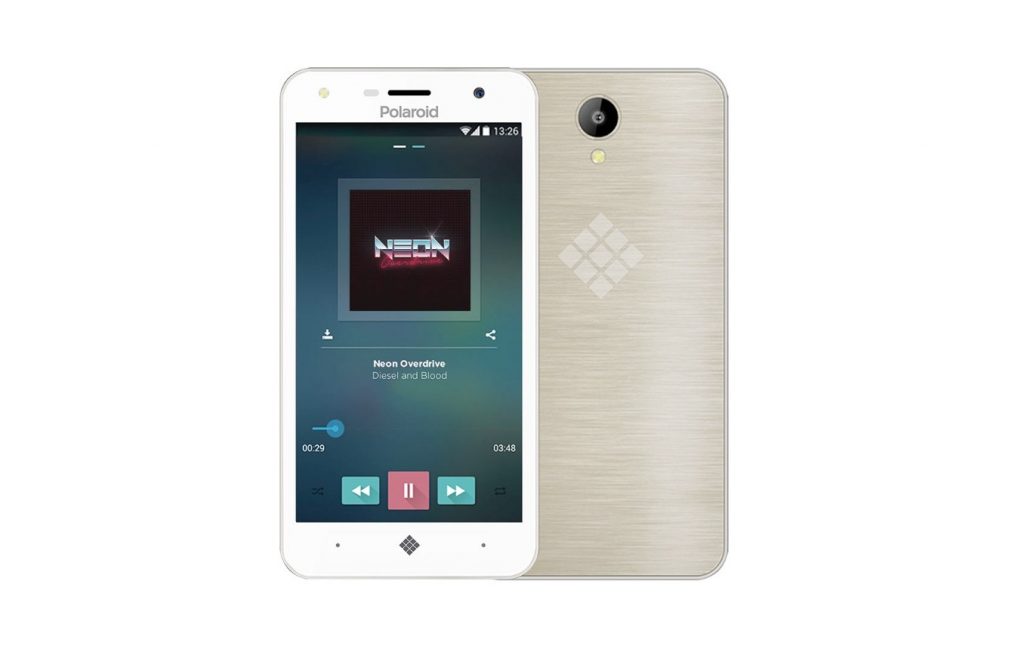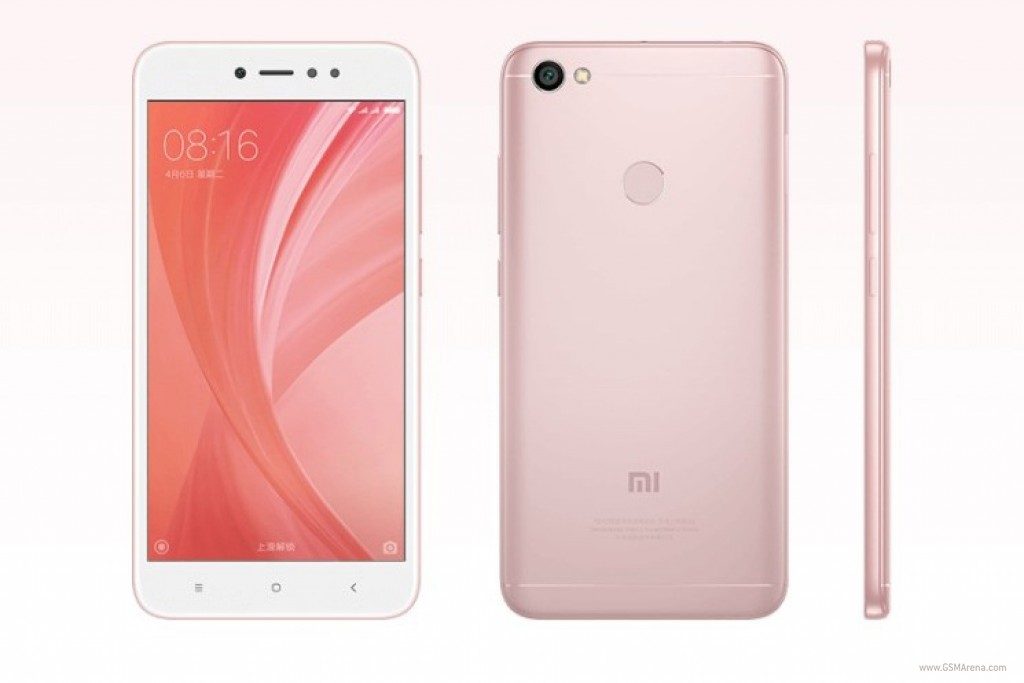
08-22: The ministry of electronics and IT of India has checked 21 smartphone makers for security purpose; Google Android 8.0 is officially Oreo; etc.
Chipsets
Qualcomm has announced its Falkor CPU core, a processor architecture intended for CPUs in data-centers. Though little info is given, this seems to be based upon an ARMv8-processor with 48 cores fabbed at 10nm. (CN Beta, Qualcomm, AnandTech, Guru3D)
Tsinghua Unigroup will render persistent support to its subsidiary Spreadtrum Communications to counter increasingly fierce competition in the domestic market for midrange to low-end mobile chips, seen especially after JLQ Technology emerged months ago as a key competitor in the form of a joint venture involving Qualcomm, the group’s chairman Zhao Weiguo has pledged. (Digitimes, press, Sohu, Sina)
Dialog Semiconductor is looking to extend its partnership with Spreadtrum Communication, and does not rule out forming a joint venture with the China-based mobile SoC provider, said Christophe Chene, senior VP of Asia for Dialog. (Digitimes, press, Sina, ESM China)
Qualcomm has an almost 10-year collaboration with TSMC, and the tie-up will extend to FinFET process technology, said Sudeepto Roy, VP of engineering for Qualcomm Technology Licensing. (Digitimes, press, UDN)
Qualcomm and Samsung have reportedly already come to an agreement on the supply of chipsets for its next-generation flagship smartphone. Samsung is said to have dibs on the Snapdragon 845 chip for the Galaxy S9. (Ubergizmo, GSM Arena, Sina, CN Beta, SouthCN)
Samsung has reportedly decided to reduce its reliance on Qualcomm chips for Galaxy S9 in 2018 in an apparent tit-for-tat against the US chipmaker for making new foundry orders with TSMC only. The latest decision comes after Qualcomm chose TSMC over Samsung as the sole producer of its next-generation 7nm mobile processor. (The Investor, Patently Apple, Android Headlines, Digitimes, C114, Sohu, Sina)
Mainland China is aggressively building its own wafer supply chain, including Zing Semiconductor’s 12” wafer monthly production of 600Kpcs in coming 4 years. Globalwafers and Wafer Works are also aggressively in expansion. Mainland China’s semiconductor import value in 2016 has reached USD250B in 2016, yet its own self-sufficiency is low. In particular, its 8” self-sufficiency only 15%, 85% relies on import; 12” is even higher, which is 99%, and mainly controlled by Japanese vendors. (EE World, HQEW, ESM China, Laoyaoba, UDN)
The market for 8” and 12” wafers has been tight due to new fab projects in China, as well as rising demand for IoT and car electronics applications, said Roger Chen, president for Wafer Works. Prices for 8” wafers are expected to rise 5%~15% in 2018, and continue their growth in 2019, Chen indicated. (Digitimes, press, Laoyaoba)
Samsung is pushing ahead with the construction of new fab Line 18 (tentative name) beside Line 17 in the Hwasung Complex of Samsung Electronics with the aim of starting construction in Nov 2017. Its building area is 40,536㎡ and one factory building will be built. It is scheduled to be completed in 2H19. The project will cost KRW6T (USD5.4B). Its main products will be non-memory semiconductors except for memories (DRAMs) and APs. (Business Korea, 52RD, Sina)
Touch Display
Display Supply Chain Consultants (DSCC) has projected the Quantum Dot LED (QLED) television shipments to reach more than 100M units by 2021 and hit a market share of 34%. Based on the 2016~2021 projections, the QLED TV market is expected to achieve a CAGR of 90% if manufacturers are able to bring down manufacturing costs and address technical issues. (Android Headlines, Forbes, iKnow)
WitsView analyst Qiu Yubin indicates that Mainland China panel fabs have support from the government, the growth is speedy. Even though in a short time they will not catch up with Taiwanese vendors, with the production is expanded rapidly, technologies and quality are going to catch up with Taiwanese vendors. Qiu believes that Hon Hai has the leverage of Mainland China. (eNanyang, Yahoo, Laoyaoba)
Japanese consultant Fuji Chimera Research Institute indicates that thanks to Apple’s OLED iPhone to be sold in 2017 fall, rigid-flex PCB (RFPCB) market size will jump to JPY171.5B, a 142% increase on year. Fuji forecasts that RFPCB will be widely adopted, which will bring the market size grow to JPY258B by 2022. (TechNews, Money DJ)
Recently Micro LED has become a hype topic in the industry, and a lot of vendors have entered this technology segment. Main vendors or new startups have been aggressively developing Micro LED technologies, and related patents numbers have increased rapidly since 2013. (UDN, Sohu, Laoyaoba)
Foxconn announced plans to build 3 facilities in the Wisconsin, US for operation as early as 2018, as part of a campus housing a USD10B liquid crystal display (LCD) factory due for 2020. The LCD plant would occupy 1,000 acres in the state’s south east. The jobs they generate will fall under the 13,000 positions that Foxconn has said its USD10B investment would directly create. (CN Beta, Reuters, Mac Rumors, BNA)
Foxconn wants to expand its offerings to include semiconductors and displays by leveraging the recent acquisition of Sharp and the potential USD27B purchase of Toshiba’s chip business, provided the latter succeeds. Foxconn’s plan is to make inroads on these industries serves as the pillar of its Flying Eagle strategy. (Business Korea, Android Headlines)
Mitac Holding has announced a plan to invest in India-based Infopower Technologies and will become a major shareholder of the firm. Infopower is a manufacturer of printed circuit board (PCB) and an electronics product assembly service provider. (Laoyaoba, Digitimes, LTN, UDN, Digitimes, press, China Times)
Memory
Micron has decided to expand production in Taiwan, and now hiring more than 1000 employees, investing USD1B. (Laoyaoba, Apple Daily)
TrendForce reports that the NAND Flash market continued to experience tight supply in 2Q17. As a result, contract prices of various lines of NAND Flash products rose by 3% to 10% from 1Q17 despite the seasonal headwinds. NAND Flash suppliers are expected to post excellent revenue results in 3Q17 due to small increases in contract prices of mobile products (i.e. eMMC and UFS) and SSDs. (Laoyaoba, TrendForce, press, TrendForce[cn], press)
Sensory
Qualcomm is entering 3D sensing market, collaborating with TSMC, Xintec, and HiMax, will enter mass production end of 2017. Other than apply it on Android smartphones, the 3D sensing technology can also be applied in drones and automotive industry. Other than that, smartphones with Qualcomm ultrasonic fingerprint scanning technology will be launched in end 2017 or beginning of 2018. (China Times, Laoyaoba, EE World, China Flash Market, Qualcomm)
Apple has a new patent that uses Bluetooth sensors that help cars communicate with each other. Sensors, likely Bluetooth short-range wireless technology, would scan the surroundings, communicating with other cars, sensors and a GPS system, updating a drivers’ dashboard display to reflect obstacles like ambulances or cars passing. (CNBC, USPTO, Laoyaoba)
According to KGI Securities analyst Ming-Chi Kuo, Qualcomm is the “most engaged” in developing 3D sensing systems for Android. However, Kuo does not see integrated systems shipping until 2019 because of immature algorithms, and “design and thermal issues” associated with a variety of hardware reference designs. Kuo believes that reticence to adopt the technology from Qualcomm will limit the technology to Xiaomi’s 2018 flagship, which will result in no more than 10M shipments, if it ships before 2019 at all. (Apple Insider, Laoyaoba)
Biometrics
According to Andy Hargreaves at KeyBanc Capital markets, Apple will remove Touch ID on the iPhone 8. Apple has reportedly been unable to get workaround solutions to work for the in-display optical fingerprint sensor. He believes Apple to ship the OLED iPhone rely on 3D sensing for biometric login and verification. He sees a negative impact for the upcoming iPhone cycle in terms of mix and units. (WCCFTech, Barron’s, MacDaily News, Sohu)
Apple has allegedly decided to ditch the Touch ID on the iPhone 8 and offer a 3D face recognition feature, dubbed Face ID, that functions accurately. The new facial recognition scanner with 3-D sensors can deeply sense a user’s face in “millionth of a second”. (Gizmo China, Korea Herald, WSJ, CN Beta, iDrop News, Business Insider)
Smartphones
The ministry of electronics and IT of India has directed 21 smartphone makers, most of which are Chinese, to inform it about the procedures and processes they follow to ensure the security of mobile phones sold in India, following reports of data leakage and theft. (Laoyaoba, India Today, BGR, BGR, Economic Times)
Suppliers in the global handset supply chain are nervously waiting for the planned release of Apple iPhone 8, Samsung Galaxy Note 8 and Huawei Mate 10 in the upcoming peak season as sales results of these new models will affect significantly the vendors’ market shares as well as follow-up orders for related suppliers. (Digitimes, press, Laoyaoba)
Google Android 8.0 is officially Oreo. Among the new feature updates are notification dots on app icons, which users can tap to quickly see what is new without opening the app completely. It also includes Android Instant App compatibility which allows users to ‘teleport’ directly into new apps right from your browser. (Android Central, Android Authority, Android, Daily Mail, CN Beta, Sohu)
Apple has bought 11 patents from Korea-based Pantech. As of the end of Mar 2017, Pantech had 2,036 Korean patents and 1,111 overseas patents. (Laoyaoba, Patently Apple, Business Korea)
Apple’s next-gen iPhone 8 is likely adopting OLED display, 3D facial recognition, wireless charging technologies. It seems Apple has chosen less well-known companies for these technologies such as Universal Display, Lumentum Holdings, AMS AG and Viavi Solution. On the other hand, Apple has reduced their reliance to some older suppliers such as Imagination Technologies. (Laoyaoba, Digitimes)
ZTE nubia Z17 with 8GB RAM variant is announced – 5.5” FHD display, Qualcomm Snapdragon 835 processor, rear dual 23MP-12MP + front 16MP cameras, 8GB RAM, 64GB ROM, USB C connector, 3200mAh battery, CNY3199. (CN Beta, CNMO, Sohu)
Polaroid launches 2 entry-level smartphones, featuring MediaTek MT6580 processor, 13MP + 5MP cameras, 1GB RAM, 8GB storage, Android 6.0, 2800mAh battery: Cosmo K – 5” HD display. Cosmo K Plus – 5.5” HD display. (GSM Arena, Polaroid, Android Police, BGR, Android Headlines)
Xiaomi Redmi Note 5a is announced – 5.5” HD LCD display, Qualcomm Snapdragon 425 / 435 processor, rear 13MP + front 5 / 16MP cameras, 2 / 3 / 4GB RAM, 16 / 32 / 64GB storage, 3080mAh battery, from CNY699. (GSM Arena, Mi.com, Gizmo China)
Internet of Things
UBS predicts that the “total cost of consumer [EV] ownership can reach parity with combustion engines from 2018”, a trend which would likely begin in Europe. UBS raises 2025 forecast for EV sales by 50% to 14.2M — 14% of global car sales. UBS reached this conclusion after tinkering with a Chevrolet Bolt EV, which it described as “the world’s first mass-market EV, with a range of more than 200 miles.” (Futurism, Laoyaoba, 163, Financial Times, Telegraph)
